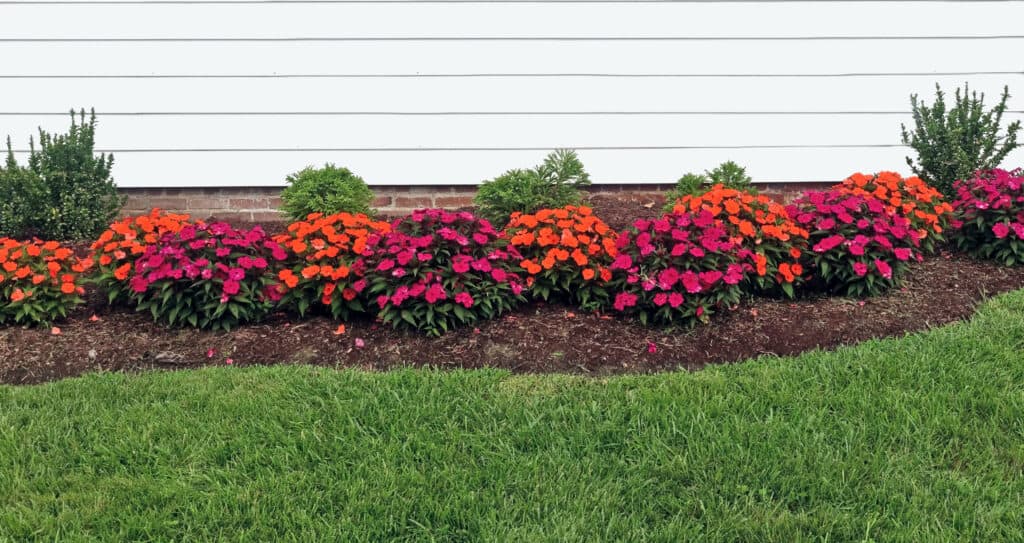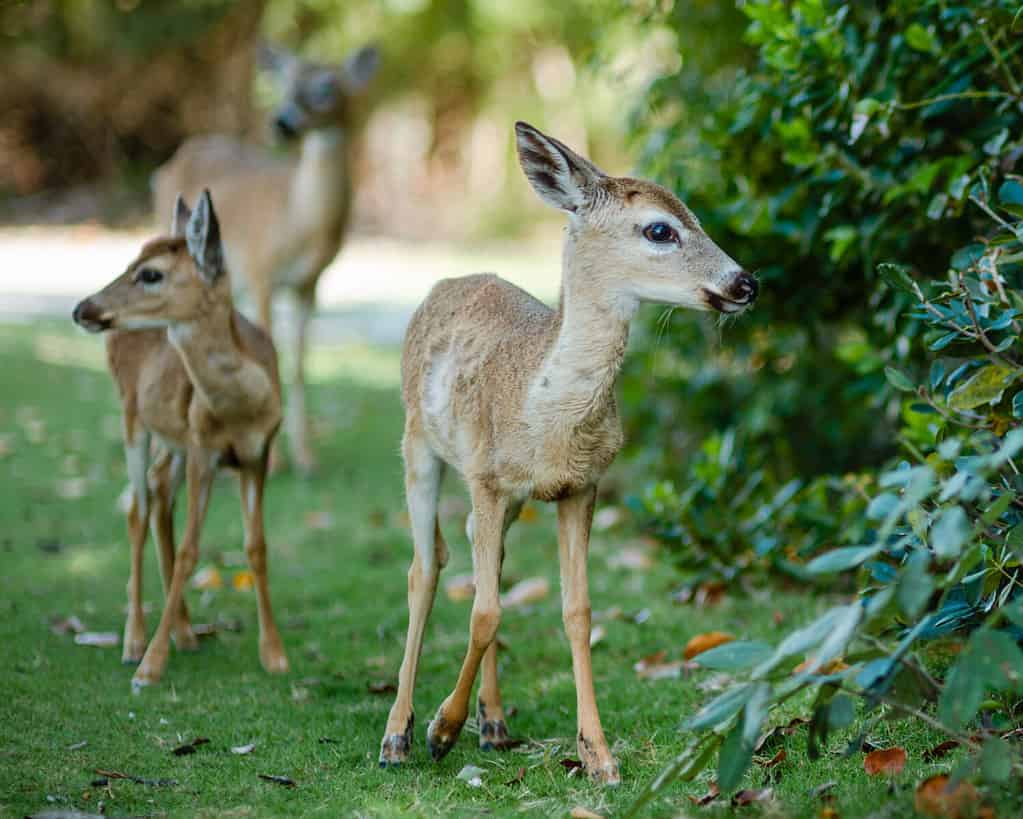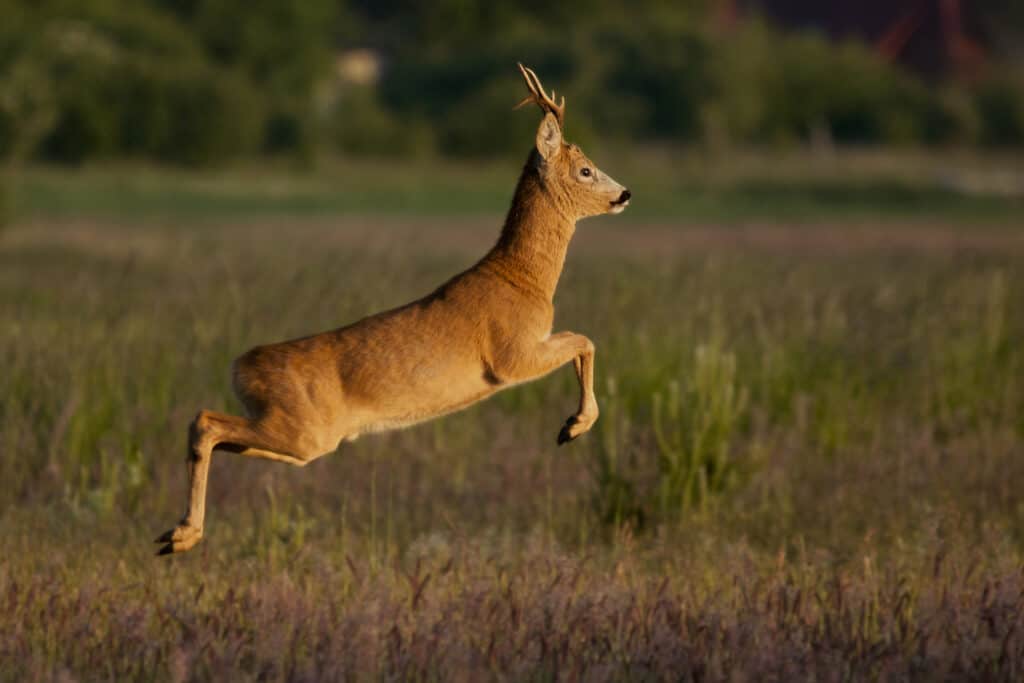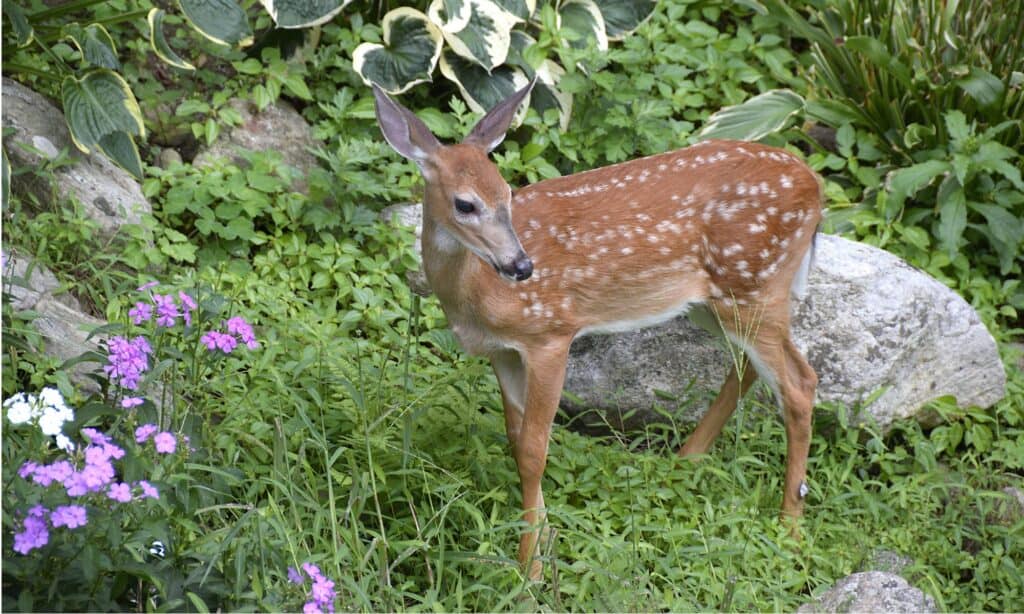Impatiens easily steal the show with their vibrant blooms and wide range of bright colors. These charming flowers love the shade and are easy to care for, making them popular choices for garden beds. But are impatiens deer resistant?
Are Impatiens Deer Resistant?

Impatiens come in bright colors and are fantastic plants for flower beds and borders.
©iStock.com/Joe_Potato
No, impatiens are not deer resistant. For some deer, these cute flowers aren’t too tasty, but for others, impatiens are a deliciously sweet treat. Deer are browsers and herbivores. They are drawn to tasty plants that are easy to eat. Impatiens smell good and have sweet-tasting leaves. The plants’ small, rounded leaves are soft and easier to chew, and the flowers are packed with sugar, water, and various nutrients. Deer enjoy munching on the entire plant, including the leaves, flowers, and stems. They are especially fond of baby plants and new growth. In addition, impatiens are often planted directly in the ground or flower pots — which are easy to access for hungry deer.
10 Ways to Keep Deer Away From Your Flowers
1. Schedule Your Planting Season

Many gardeners enjoy impatiens in garden beds or as hanging plants.
©Aria Pearlilla/Shutterstock.com
Deer activity varies depending on where you live. In some areas, deer are most active toward the end of winter and early spring. In others, deer target impatiens during the late summer and early fall. By figuring out the peak deer season in your area, you can try planning your impatiens at a different time of year to give them a better chance against hungry critters.
2. Use Garden Netting

Mesh or garden netting is typically inexpensive and can be reused.
©encierro/Shutterstock.com
Garden netting is a type of mesh fabric that you can use to create a physical barrier around your plants. The mesh size is usually fine enough to discourage deer from poking through, keeping your flowers safe from hungry mouths. Made from strong but lightweight materials, garden netting won’t hurt your plants and is nearly invisible from afar. Deer are often confused by this barrier, which keeps them away from your flowers.
3. Grow Plants Nearby That Repel Deer

Deer have sensitive sniffers and often avoid strong-smelling plants.
©Abigail Marie/Shutterstock.com
While no plant is completely deer-proof (especially against a very hungry deer), some options are far less appealing to these eager herbivores. Surrounding your impatiens with these deer-repellent plants helps to provide a strategic defense. Strong-smelling plants like lavender, mint, sage, peonies, and bearded irises can mask the sweet scent of your impatiens, making them less appetizing for deer to snack on.
4. Fence Your Yard or Garden

Deer are impressive jumpers, but they must feel safe before attempting to leap.
©Tomasz Wrzesien/Shutterstock.com
A fence can be a great defense against deer, but needs to be at least 6 feet tall to be effective. Deer can jump 8 feet into the air without trouble. The key is to create a barrier that feels uncertain, decreasing their confidence in jumping over it. A fence with a slight outward angle can make it even harder for them to jump. In addition, a tall, solid fence keeps them from seeing what’s on the other side, making them less likely to leap over.
4. Plant Impatiens in an Area with Less Deer Traffic

Impatiens are also called “Busy Lizzies”.
©Yui Yuize/Shutterstock.com
Location and strategic placement are another secret weapon against deer. Deer favor open areas where they can graze without worry, so plant your impatiens near natural cover like shrubs or trees. Slopes can also be a deterrent to make deer less comfortable. In addition, if you know there are deer highways across your yard, plant your impatiens in a different area. Many people fill flower beds and pots with impatiens, which are convenient and easy to access for hungry deer. Consider planting your impatiens in a hanging basket instead, putting them safely out of reach.
5. Use Your Scent

If you have a dog that sheds, save their hair and sprinkle it around your impatiens.
©Rabinger Photography/Shutterstock.com
Deer have an incredible sense of smell and can detect delicious plants from far away. They can also smell humans, but this is a smell they tend to avoid. Deer typically feel less comfortable enjoying dinner with a human nearby. So, try sprinkling human hair clipping or even dog fur around your impatiens as a fragrant deterrent. After rain or heavy winds, this method may need to be repeated.
7. Use Bells or Wind Chimes

Capitalize on the caution of deer by hanging wind chimes in your garden.
©Qcon/Shutterstock.com
Deer are naturally skittish and always on alert. Loud or unexpected noises make them jumpy, but you can use this to your advantage. Hanging tin cans, wind chimes, or bells in your garden to create unpredictable sounds to make the area less desirable for a hungry deer.
8. Install Motion Activated Lights

Motion-activated lights are helpful for deterring deer at night.
©bubutu/Shutterstock.com
Another way to keep deer from your impatiens is by installing motion-activated lights. An unexpected burst of light can be quite startling for a deer, especially at night. However, during the day motion activated lights are not as effective. In addition, some deer may adapt to the lights over time.
9. Use Motion-Activated Sprinklers

There are even solar-powered motion-activated sprinklers that are easy to use.
©iStock.com/MaYcaL
While motion-activated lights help to deter deer at night, motion-activated sprinklers can offer protection during the day as well. In addition, a sudden splash of water is a rather startling surprise for an unsuspecting deer, and they don’t enjoy getting soaked. For best results, place the sprinkler directly over your impatiens so deer cannot avoid it.
10. Try Deer Repellent Spray

Deer repellent sprays can be useful but may need to be reapplied.
©iStock.com/tmphoto98
Many manufacturers offer various types of deer repellent sprays that can help shield your impatiens. These sprays contain tastes or scents that deer find offensive, encouraging them to find dinner elsewhere. But always double-check the label to ensure the spray is safe and uses natural ingredients. Certain chemicals can be harmful to your flowers as well as children and pets.
The photo featured at the top of this post is © Aria Pearlilla/Shutterstock.com
Thank you for reading! Have some feedback for us? Contact the AZ Animals editorial team.







